Best Microsoft MCTS Training – Microsoft MCITP Training at Certkingdom.com
In 1985, Microsoft released version 1.0 of the graphical desktop operating system known as Windows. Over the next 25 years, the industry would see over 16 significant versions of the now-ubiquitous OS. In honor of this anniversary, let’s take a look back at Windows’ major revisions through the ages.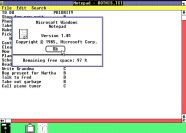
Back in 1985 the first version of Windows was a primitive affair. To avoid legal issues with the Mac OS, Microsoft had to ensure that application windows did not overlap and that there was no trash can to be seen. However, Windows 1.x did include a taskbar across the bottom of the screen.
Windows 2.0
Windows 2.0 (1987)
Windows 2.0 introduced overlapping windows and slightly improved graphics, while nixing the taskbar of its predecessor. It included a suite of familiar, simple applications (Paint, Terminal, Clock) and a file manager called MS-DOS Executive.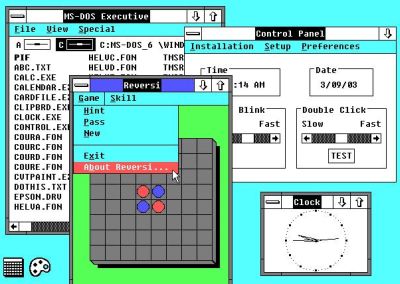
The first Windows versions of Microsoft Word and Microsoft Excel ran on Windows 2.0. Third-party developer support for Windows increased substantially with this version (some shipped the Windows Runtime software with their applications, for customers who had not purchased the full version of Windows). However, most developers still maintained DOS versions of their applications, as Windows users were still a distinct minority of their market.
Windows 3.0Windows 3.0 (1990)
Windows 3.0 introduced a host of new features: Program Manager, Solitaire, support for VGA and virtual memory, and a new “3D” look. Third-party support was stronger than ever, which (when combined with the new features) made Windows 3.0 the first widely used Windows release.
This version of Windows was the first to be pre-installed on hard drives by PC-compatible 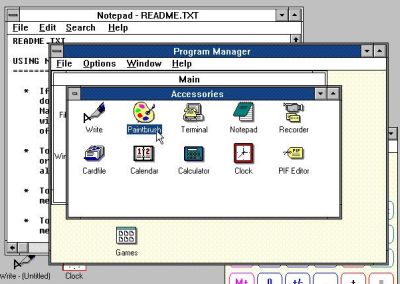 manufacturers. Zenith Data Systems had previously shipped all of its computers with Windows 1.0 or later 2.x on diskettes but committed early in the development of Windows 3.0 to shipping it pre-installed. Indeed, the Zenith division had pushed Microsoft hard to develop the graphical user interface because of Zenith’s direct competition with Apple in the college and university market.
manufacturers. Zenith Data Systems had previously shipped all of its computers with Windows 1.0 or later 2.x on diskettes but committed early in the development of Windows 3.0 to shipping it pre-installed. Indeed, the Zenith division had pushed Microsoft hard to develop the graphical user interface because of Zenith’s direct competition with Apple in the college and university market.
Windows 3.0 was not available as a run-time version, as was the case with its predecessors. A limited-use version of Windows 2.x was often bundled with other applications (i.e. Ami Pro) due to the low market penetration of Windows itself.
Windows 3.1Windows 3.1 (1992)
Windows 3.1 improved significantly upon its predecessor with the inclusion of scalable TrueType fonts, turning Windows into a serious platform for desktop publishing. This version also improved drag-and-drop functionality and OLE (Object Linking and Embedding), and it introduced multimedia support for the first time.
Windows 3.1 was designed to have backward compatibility with older Windows platforms. As with Windows 3.0, version 3.1 had File Manager and Program Manager, but unlike all previous versions, Windows 3.1 and later support 32-bit disk access, cannot run in real mode, and included Minesweeper instead of Reversi (though Reversi was included in some copies).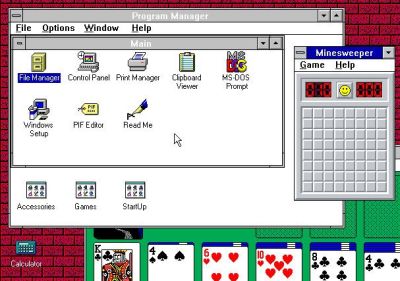
Windows 3.1 Multimedia PC Version (Beta only, released Nov 1992 — codenamed Bombay) Included a media viewer, and the ability to play video files. It was targeted to the new multi-media PC and included sound and video integration with CD-ROM support.
Windows 3.1 for WorkgroupsWindows for Workgroups 3.1 (1992)
This version of Windows took the standard Windows 3.1 base and added native networking support–especially for LANs, which were gaining popularity in businesses at the time. It included relatively sophisticated along with the usual complement of simple Windows applications it comes with SMB file sharing support via the NetBIOS based NBF and/or IPX network transport protocols, includes the Hearts card game, and introduced VSHARE.386, the Virtual Device Driver version of the SHARE.EXE Terminate and Stay Resident program.
Windows NT 3.1Windows NT 3.1 (1993)
Windows NT sprang forth from work on OS/2. It represented an entirely new 32-bit OS (previous Windows editions were graphical shells for MS-DOS) that targeted high-end workstation and server applications. Its first version sported a look and feel similar to that of Windows 3.1, but its underpinnings were completely original.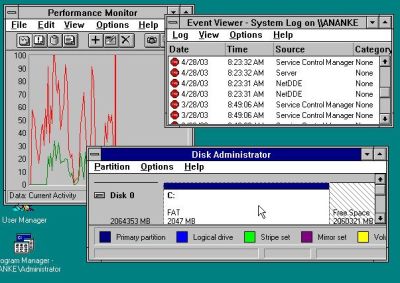
Windows NT 3.1 is the first release of Microsoft’s Windows NT line of server and business desktop operating systems, and was released to manufacturing on 27 July 1993. The version number was chosen to match the one of Windows 3.1, the then-latest operating environment from Microsoft, on account of the similar visual appearance of the user interface. Two editions of NT 3.1 were made available, Windows NT 3.1 and Windows NT Advanced Server.It could run on Intel x86, DEC Alpha, and MIPS R4000 CPUs.
Windows 95Windows 95 (1995)
Microsoft continued development of its DOS-based consumer OS line with Windows 95, which didn’t require a separate DOS install. It introduced the now famous taskbar and Start menu, along with dozens of other improvements that garnered strong sales and cemented Microsoft’s domination of the desktop-OS marketplace.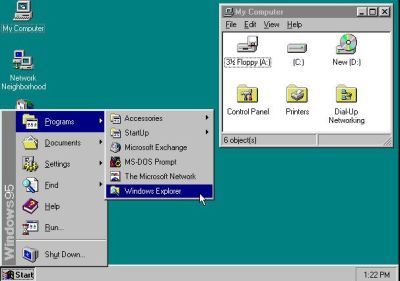
It featured significant improvements over its predecessor, Windows 3.1, most notably in the graphical user interface (GUI) and in its relatively simplified “plug-n-play” features. There were also major changes made at lower levels of the operating system, such as moving from a mainly 16-bit architecture to a pre-emptively multitasked 32-bit architecture.
In the marketplace, Windows 95 was a major success, and within a year or two of its release had become the most successful operating system ever produced. It also had the effect of driving other major players in the DOS-compatible operating system market out of business, something which would later be used in court against Microsoft.
Windows NT 4.0Windows NT 4.0 (1996)
Windows NT 4.0 integrated Windows 95-like interface improvements with the very stable Windows NT kernel, further advancing the NT line to a point where it became Microsoft’s most popular business release for the next few years.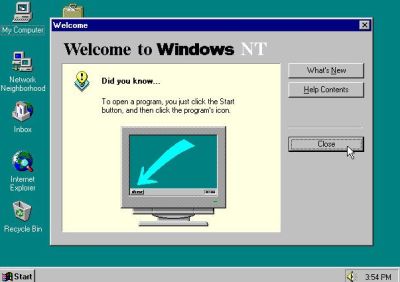
While providing much greater stability than Windows 95, it was also less flexible from a desktop perspective. Much of the stability is gained by the use of protected memory and the hardware abstraction layer. Direct hardware access was disallowed and “misbehaving” applications were terminated without needing the computer to be restarted. The trade-off was that NT required an excessive amount of memory in comparison to consumer targeted products such as Windows 95.
While nearly all programs written for Windows 95 will run on Windows NT, the majority of 3D games will not, due in part to NT 4.0 having limited support for DirectX. Third-party device drivers were an alternative that could access the hardware directly, but poorly written drivers became a frequent source of “stop errors”. Such failures began to be referred to as the “blue screen of death” or BSOD and would require the system to be restarted in such cases. These errors were rare and it was not uncommon for NT servers or workstations to run for months at a time without failure. By comparison Windows consumer versions at the time were much less stable and popularized the belief that all Windows versions were unreliable.
Windows NT 4.0 is also less user-friendly than Windows 95 when it comes to certain maintenance and management tasks; for instance, by default there is no Plug and Play support (although limited support could be installed later) which greatly simplifies installation of hardware devices. Many basic DOS applications would run, however graphical DOS applications would not run due to the way they accessed graphics hardware.
Windows CE 1.0
Windows CE 1.0 (1996)
Here we’re taking a slight detour from our survey of desktop Windows versions to consider the first pocket version, Windows CE. This completely independent OS appeared alongside the advent of a new generation of handheld computers in the mid- to late 1990s, and it lives on as part of Windows Mobile today.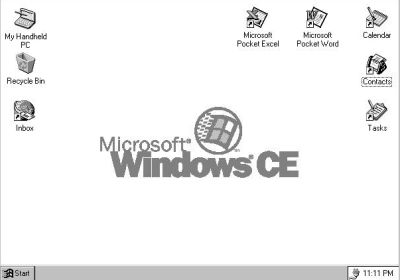
Windows CE is a distinct operating system and kernel, rather than a trimmed-down version of desktop Windows.It is not to be confused with Windows XP Embedded which is NT-based.
Microsoft licenses Windows CE to OEMs and device makers. The OEMs and device makers can modify and create their own user interfaces and experiences, while Windows CE provides the technical foundation to do so.
Windows CE is supported on Intel x86 and compatibles, MIPS, ARM, and Hitachi SuperH processors.
Windows 98Windows 98 (1998)
Microsoft’s Windows 98 made the Internet Explorer Web browser an inextricable part of Windows, allowing Web pages to render in Explorer windows or on the desktop. It also added the quick launch toolbar and native USB support, among other features. It proved to be a popular (albeit unstable) OS.
It was released to manufacturing on 15 May 1998 and to retail on 25 June 1998. Windows 98 is the successor to Windows 95. Like its predecessor, it is a hybrid 16-bit/32-bit monolithic product with an MS-DOS based boot loader.
Windows 2000
Windows 2000 (2000)
As a member of the NT line, Windows 2000 added Windows 98’s Web integration to a stable, relatively secure OS designed for workstation and server environments. It also eliminated the need for many reboots when people installed software or changed system settings. It saw heavy use as a desktop OS.
Four editions of Windows 2000 were released: Professional, Server, Advanced Server, and Datacenter Server. Additionally, Microsoft sold Windows 2000 Advanced Server Limited Edition and Windows 2000 Datacenter Server Limited Edition, which were released in 2001 and run on 64-bit Intel Itanium microprocessors.While each edition of Windows 2000 was targeted to a different market, they share a core set of features, including many system utilities such as the Microsoft Management Console a nd standard system administration applications.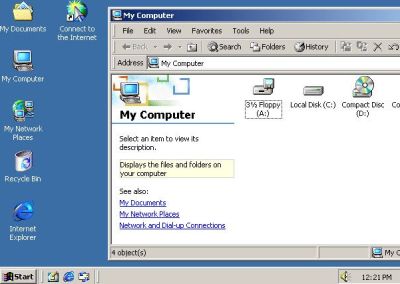
Support for people with disabilities has been improved over Windows NT 4.0 with a number of new assistive technologies,and Microsoft increased support for different languages and locale information.
All versions of the operating system support the Windows NT file system, NTFS 3.0,the Encrypting File System, as well as basic and dynamic disk storage.The Windows 2000 Server family has additional features, including the ability to provide Active Directory services (a hierarchical framework of resources), Distributed File System (a file system that supports sharing of files) and fault-redundant storage volumes. Windows 2000 can be installed through either a manual or unattended installation. Unattended installations rely on the use of answer files to fill in installation information, and can be performed through a bootable CD using Microsoft Systems Management Server, by the System Preparation Tool.
Microsoft marketed Windows 2000 as the most secure Windows version ever,but it became the target of a number of high-profile virus attacks such as Code Red and Nimda.For ten years after its release, it continued to receive patches for security vulnerabilities nearly every month until reaching the end of its lifecycle on 13 July 2010.
Windows MeWindows ME (2000)
As the last gasp of MS-DOS-based Windows, this long-in-the-tooth, highly unstable release was reviled by users and critics alike. Windows ME emphasized multimedia and user-friendliness above all, but reality veered far from Microsoft’s intentions and proved how badly we needed XP.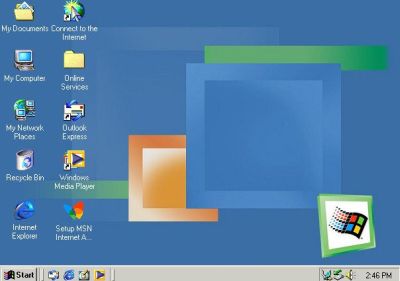
It included Internet Explorer 5.5, Windows Media Player 7, and the new Windows Movie Maker software, which provided basic video editing and was designed to be easy for home users. Microsoft also updated the graphical user interface and the shell features and Windows Explorer in Windows Me with some of those first introduced in Windows 2000, which had been released as a business oriented operating system seven months earlier. Windows Me could be upgraded to Internet Explorer 6 SP1, but not to SP2 (SV1) or Internet Explorer 7, and Windows Media Player 9 Series. Microsoft .NET Framework up to and including version 2.0 is supported, however versions 2.0 SP1, 3.x, and greater are not. Office XP was the last version of Microsoft Office to be compatible with Windows 9x.
Windows Me is a continuation of the Windows 9x model, but with access to real mode MS-DOS restricted in order to speed up system boot time.This was one of the most unpopular changes in Windows Me, because applications that needed real mode DOS to run, such as older disk utilities, did not run under Windows Me (although the system could be booted into real mode DOS using a bootable Windows Me floppy disk).
Compared with other releases of Windows, Windows Me had a short shelf-life of just over a year.
Windows xp
Windows XP (2001)
At long last, Windows XP integrated Microsoft’s stable and mature NT OS line with its 9x line of consumer OSs. The result was the company’s most popular operating system to date–a release that provided a colorful new interface and security enhancements while retaining backward compatibility with previous versions of Windows.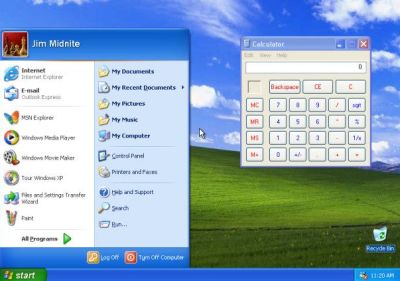
The most common editions of the operating system are Windows XP Home Edition, which is targeted at home users, and Windows XP Professional, which offers additional features such as support for Windows Server domains and two physical processors, and is targeted at power users, business and enterprise clients. Windows XP Media Center Edition has additional multimedia features enhancing the ability to record and watch TV shows, view DVD movies, and listen to music. Windows XP Tablet PC Edition is designed to run stylus applications built using the Tablet PC platform.
Windows XP was eventually released for two additional architectures, Windows XP 64-bit Edition for IA-64 (Itanium) processors and Windows XP Professional x64 Edition for x86-64. There is also Windows XP Embedded, a component version of the Windows XP Professional, and editions for specific markets such as Windows XP Starter Edition. By mid 2009, a manufacturer revealed the first Windows XP powered cellular telephone.
According to web analytics data generated by W3Schools, as of October 2010[update], Windows XP is the most widely used operating system for accessing the Internet in the world with a 48.9% market share, having peaked at 76.1% in January 2007
Windows Server 2003
Windows Server 2003 (2003)
Windows Server 2003 continued the tradition of NT-based server OSs while including interface improvements that had arrived with Windows XP two years earlier.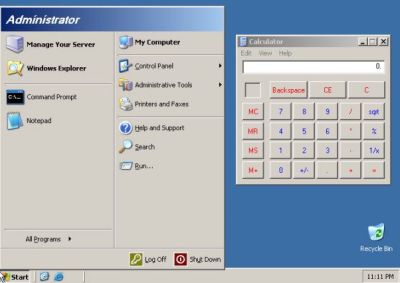
Windows Server 2003 comes in a number of editions, each targeted towards a particular size and type of business.In general, all variants of Windows Server 2003 have the ability to share files and printers, act as an application server, and host message queues, provide email services, authenticate users, act as an X.509 certificate server, provide LDAP directory services, serve streaming media, and to perform other server-oriented functions.
Windows Vista
Windows Vista (2007)
By 2007, Microsoft was feeling the heat from Mac OS X, which made Windows XP look two decades out of date. The folks in Redmond answered with a new OS dubbed Windows Vista, cloaked in the flashy, translucent Aero interface and sporting larger icons, Gadgets, and a new Start menu. Critics weren’t impressed.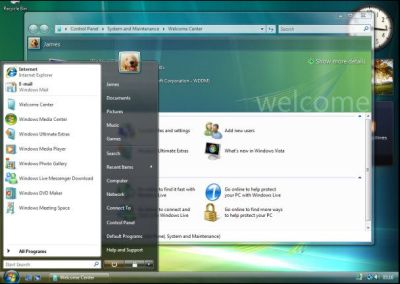
Prior to its announcement on July 22, 2005, Windows Vista was known by its codename “Longhorn.”Development was completed on November 8, 2006; over the following three months it was released in stages to computer hardware and software manufacturers, business customers, and retail channels. On January 30, 2007, it was released worldwide, and was made available for purchase and download from Microsoft’s website.The release of Windows Vista came more than five years after the introduction of its predecessor, Windows XP, the longest time span between successive releases of Microsoft Windows desktop operating systems.
Windows Server 2008
Windows Server 2008 (2008)
Windows Server 2008 was essentially the server version of Windows Vista–minus the dizzyingly flashy Aero environment. Microsoft had long since learned that fancy, colorful graphics didn’t go over well in business circles.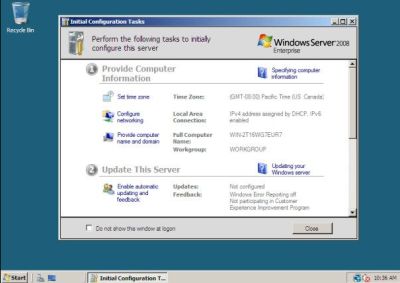
Released to manufacturing on February 4, 2008, and officially released on February 27, 2008, it is the successor to Windows Server 2003, released nearly five years earlier. A second release, named Windows Server 2008 R2, was released to manufacturing on July 22, 2009.Like Windows Vista and Windows 7, Windows Server 2008 is built on Windows NT 6.x.
Windows 7
Windows 7 (2009)
With Microsoft getting a shellacking in the press for the Vista debacle, the OS giant rushed a successor to market that addressed many of Vista’s problems. The result was Windows 7, which gained critical praise and renewed Windows’ viability in the face of threats from both mobile platforms and Apple.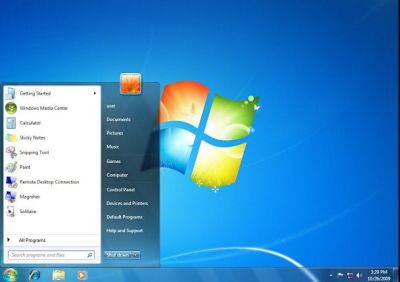
Windows 7 was released to manufacturing on July 22, 2009,and reached general retail availability on October 22, 2009,less than three years after the release of its predecessor, Windows Vista. Windows 7’s server counterpart, Windows Server 2008 R2, was released at the same time. Unlike its predecessor, Windows Vista, which introduced a large number of new features, Windows 7 was intended to be a more focused, incremental upgrade to the Windows line, with the goal of being compatible with applications and hardware which Windows Vista was not at the time.[7] Presentations given by Microsoft in 2008 focused on multi-touch support, a redesigned Windows shell with a new taskbar, referred to as the Superbar, a home networking system called HomeGroup, and performance improvements. Some standard applications that have been included with prior releases of Microsoft Windows, including Windows Calendar, Windows Mail, Windows Movie Maker, and Windows Photo Gallery, are not included in Windows 7;most are instead offered separately at no charge as part of the Windows Live Essentials suite.
